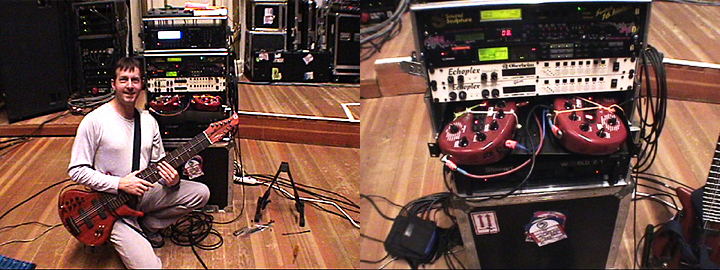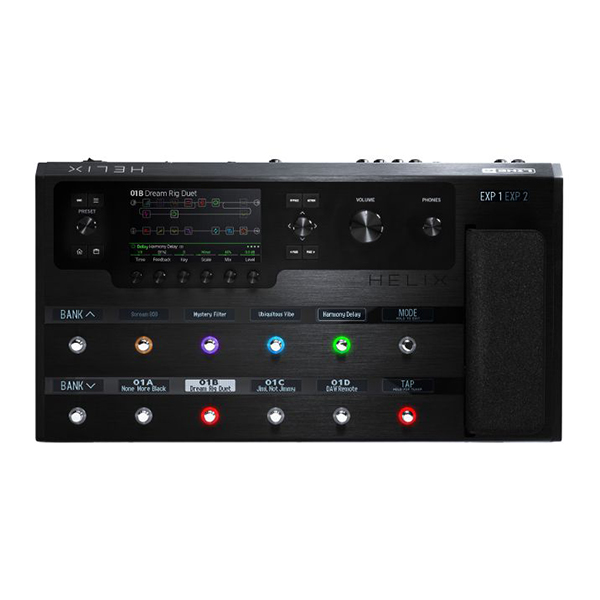Not Guitar: Touch Guitarists Markus Reuter and Trey Gunn Conjure Cosmic Tones and Soundscapes From Helix
by Barry Cleveland
Touch guitarists Markus Reuter and Trey Gunn are singular artists who play extended-range instruments that encompass both the guitar and bass registers, and which are played by tapping the strings with both hands, much like the Chapman Stick (from which they were derived conceptually). Reuter and Gunn also deftly deploy Helix amp and effects processors when crafting their idiosyncratic tones and expansive soundscapes.
Reuter has been a member of Stick Men (alongside Tony Levin and Pat Mastelotto) for more than a decade, as well as performing solo and with a variety other adventurous ensembles, including Centrozoon and Tuner. He has released eight albums as a leader; collaborated on recordings with Ian Boddy, Robert Rich, Stephan Thelen, and other artists; and appeared as a guest on dozens of additional recordings. He is also an educator and hosts the video program Living the Dream. Reuter primarily plays 8- and 10-string Touch Guitars, which he designed, and currently relies on Helix Floor and HX Stomp processors to generate nearly all of his extraordinary sounds.
Gunn was a member of King Crimson from 1994 to 2003, as well as recording and performing with dozens of other luminaries, such as David Sylvian, Vernon Reid, Brian Eno, John Paul Jones, Steven Wilson, and Robert Fripp. He is a member of TU, KTU, 3Below, Quodia, and The Security Project, and has released 14 solo albums. Gunn also composes music for film and television, teaches, and runs the 7d Media label. His principal instrument is the 10-string Warr Guitar, which he developed with Mark Warr, and he has incorporated Helix Native into his live and recording rigs.
Both musicians studied Guitar Craft with Robert Fripp for a number of years and were active in the associated community in various roles.
When did you first begin using Line 6 processors?
Trey: I began using the original red POD back in 1999 or 2000. I can’t remember exactly why I was drawn to it, other than that it was the first amp-simulation device and there was nothing else like it at the time. That was also about the time that Tony Levin and I were both playing around with using distortion on the bass and we were trying to figure out how to do it without losing the bottom end. So, I ran the dry signal parallel to the distorted POD signal, using a giant rig with 16 audio loops, which is ridiculous by today’s standards, when you can do the same thing within Helix. And I actually used two PODs, one for each side of the instrument, as there are individual outputs for the guitar and bass sides. The PODs were mounted on a shelf with zip ties.

Markus: Stick Men has been touring the world for the past decade and I have used Line 6 gear for nearly the entire time, beginning with the POD HD500 on the second or third tour. It had that small display, but at least you could modify the signal path a little bit, and I liked the way it sounded. For me, all the concerns about “authentic” tones are really irrelevant, as when I plug my instrument into a modeler, it isn’t going to sound like anything else anyway. So, with that I was able to find my own sounds, including synth sounds, as there was an onboard monophonic string synth that was very useful for doing soundscape stuff. I also liked the distortions, as they were grittier and more raw-sounding than those in other processors, in a way that really worked for me. But even back then, I was already dreaming about something very much like Helix, so when it appeared it was literally a dream come true. The inserts, the four effects loops, the multiple outputs, Snapshots—all those things. And the ease of use is still unmatched. I could go on and on, because I really love that thing!
That’s an interesting point about authentic tones, which I believe has something to do with modeling philosophy. For example, when modeling an old amp like a plexi Marshall, you can either lean toward raw realism, warts and all, or lean toward a more idealized or produced sound.
Trey: I’ve actually never played through a plexi Marshall, as amps aren’t really part of my world. Sort of like Markus, I think of amp simulations as just effects. These days, the way I test new gear is to start with the cleanest signal, full range, and if I use an amp, it’s because it’s an effect and I actually want to limit that range. Even the lowest string on my guitar side is really low. So, starting with the full sound, as soon as I run it through an amp simulation I lose that. I like the amps, but they are just very specific, like if I want to make a smaller or grungier sound.
Markus Reuter: “Sacred Thread” from Anchor and Burden.
Markus: I’m with you, but I think what has changed recently, though, is that there are also bass amps in Helix, and those work better now.
Trey: Yeah, yeah. Well, I do like that the bass amp simulations now are more full-range, and I tend to go there even on the top side when I want a cleaner but a more, I don’t know, gushier sound. But for me, on my instrument, I don’t hear that much difference between the different guitar amp simulations. I’m more into the fuzz and the overdrive and the delays and other effects. And if I need a crunchy thing that’s not a fuzz, then I might go to amps.
Markus: I agree. And for me, the amp doesn’t even have to be at the end of the signal chain. Maybe I put the amp first, and then I go through a fuzz?
Trey: Right.
Markus: That sound design aspect is one of the things I like most about Helix. Another example would be the speaker, which can be separate from the amp, and you can put things between the amp and the speaker if you want to, and change the order of everything. With our instruments, Trey, to be honest they don’t sound like guitars or basses.
Trey: No. And they certainly don’t respond like them, either.
Markus: It’s just very, very different. And that’s why usually, when I’m going for a clean sound, I go into the 1176 thing [LA Studio Comp] and crank it up just a bit to get a little dirt and control, and that’s what I use for clean. I wouldn’t send that signal through an amp. It’s almost pointless with our instruments.
Trey: Yeah.
King Crimson: “The Deception Of The Thrush” live.
Markus: And I know Tony Levin is the same. He built this isolation room in his home studio, with an amp in it, and in the beginning he was re-amping both his Chapman Stick and his bass—but in the end he always just wound up using the DI signal [laughs].
Trey: Yeah. But then there’s the parallel processing thing, which I do a lot, with the dry or clean signal on one path and the effected sound on the other. And besides just blending them, I also crossfade between the two a lot, which is a really cool sound, and something that is easy to do within Helix.
Elaborate a little on how you create signal chains specifically designed to enhance your particular instruments as opposed to a guitar. For example, are you using both Path 1 and Path 2, and the A and B options for each one?
Trey: I’m using the Helix Native plugin in a very unconventional way, which is within a VST host called Gig Performer. It lets me run multiple plugins together and control them from a single point, doing pretty much the same sorts of routing things you can do inside of Helix, including parallel routing, outside of Helix. I was using Gig Performer before I got Helix, and now a lot of what I was doing is obsolete—though I still like to run some stuff alongside it. Gig Performer also lets me use an expression pedal to do things like change delay times outside of Helix while crossfading within Helix, or pitch shift within Helix while doing something else outside of it at the same time. I could even run two instances of Helix Native in parallel if I had enough CPU to handle it.
Trey Gunn and Markus Reuter Live at SeaProg 2019.
When it comes to crafting Helix presets, I’ll often start with some factory presets that seem promising, then remove all the stuff I don’t really use, like chorus, compressors, and even amps, unless there are two amps in stereo or something, which I can build on. By cleaning things up like that, I can really save on CPU usage.
Regarding parallel processing the two sides, when I’m processing sounds that are happening in the upper register, with maybe a fuzz or something, I don’t worry about low-frequency loss anyway. Otherwise, I’ll use a band-pass equalizer to get the two sounds to fit together, and then blend them together. That’s actually the same thing I used to do back when I was using two PODs in parallel: to keep them from just sounding like two separate sounds, I’d EQ them using a little preamp and then route the combined mono signal into an Empirical Labs EL8 Distressor or a dbx 160A compressor to mush them together even more. Of course, all of that can be done inside Helix now.
Markus, since you use Helix hardware, I imagine your approach is somewhat different?
Markus: Yes. Typically, what I want to have in a preset is a clean sound, a lead sound, a bass sound, and an ambient pad kind of sound—and Snapshots make it easy to do that. As for the actual signal chains and path allocations, they largely just depend on what I need to do. For example, when I was touring with Devin Townsend, some of his songs required me to have as many as ten different immediately accessible sounds, so I had to figure out how to organize everything to be able to do that.
One of the problems I had when using the POD HD500 was that it was difficult to have both a good bass sound and a good lead sound in the same space, and switching between one sound and the other wasn’t an option. For example, with Stick Men, Tony Levin and I would often swap roles within songs, sometimes within a 32nd note, where, say, on the down beat I’d go from playing bass to playing lead, and then four bars later I’d switch back again. So, the two discrete signal paths in Helix, combined with Snapshots, enable me do that easily, and even the delay repeats and reverb tails aren’t interrupted.
What about all of the sophisticated looping that you do?
Markus: The loopers in Helix, and even HX Stomp, are all I need to do some gigs, but I’ll often route the Helix sound into my laptop using a little two-channel Focusrite interface, and do the looping with software. I don’t use the built-in Helix audio interface just because I feel it is simpler and safer not to. So, the mono lead and bass sounds are routed directly to the P.A. via the XLR outputs, and the stereo ambient sounds are routed to the laptop using the 1/4″ outputs. Of course, with Helix the ambient sounds can also be sent to the XLR outputs if I want, depending on how the routing is configured within the individual preset.
Markus Reuter In Discussion with Trey Gunn
A variation on this would be the setup I used on the Devin Townsend tour, where instead of using a laptop for looping, I used an HX Stomp inserted into the effects loop of the Helix, and controlled it via MIDI. On a song called “War,” Devin wanted me to silently record a loop as he was still talking to the audience between songs, so that the loop could come in on the downbeat with everyone else as the next song began.
Trey: When we did the duo gig at Sea Prog [see video] and you were only using the HX Stomp, didn’t you also have HX Edit open on your laptop?
Markus: Yes, that’s what I usually do when I’m recording, and for some less-demanding gigs like that show. I also used that setup for the improvised online performances I did during lockdown, where I would have Zoom, HX Edit, and Ableton Live all open on my laptop, chugging away in the background. The editor allows me to easily tweak parameters in real time as I go.
What is an example of a really strange sound that you created with Helix?
Trey: One of the more unusual things I like to do is to run a pitch shifter set to a minor second and a major second into a fuzz, and then use an expression pedal to shift between those intervals. It’s actually a really annoying sound [laughs]. And I do something very similar using a ring modulator, where the expression pedal controls the frequency, and depending on what you are playing it either matches or it doesn’t.
Markus: I created a preset called Reuter Lead for the Helix 3.0 Artist Presets collection, which was one that I used on an album with Ian Boddy called Outland, that is actually distributed by Trey’s 7d Media label. But I also created another preset called Markus Reuter Glitch that featured the Glitch Delay. I thought, “Okay, the Glitch Delay is supposed to be glitchy, how can I make it even more so?” So I assigned the expression pedal to several of its parameters, so that when you move the pedal you get different configurations of those parameters, which obviously makes it glitch big time. I actually submitted that preset, as well, but I guess Line 6 found it to be a little too strange and didn’t take it!
Photo of Marcus Reuter: Maciej Wasilewski
More on Helix: https://line6.com/helix/

Barry Cleveland is a Los Angeles-based guitarist, recordist, composer, music journalist, and editor-in-chief of Model Citizens and The Lodge, as well as the author of Joe Meek’s Bold Techniques and a contributing author to Stompbox: 100 Pedals of the World’s Greatest Guitarists. Barry also served as an editor at Guitar Player magazine for 12 years and is currently the Marketing Communications Manager at Yamaha Guitar Group. barrycleveland.com
Related posts
By submitting your details you are giving Yamaha Guitar Group informed consent to send you a video series on the Line 6 HX Stomp. We will only send you relevant information. We will never sell your information to any third parties. You can, of course, unsubscribe at any time. View our full privacy policy






Leave a Reply
You must be logged in to post a comment.